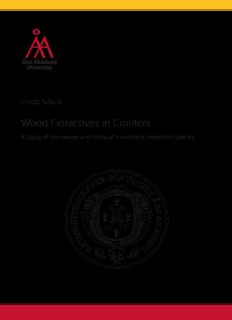
Linda Nisula PDF
Preview Linda Nisula
Linda Nisula Wood Extractives in Conifers L in Johan Gadolin d Process Chemistry Centre a N A Study of Stemwood and Knots of Industrially Important Species is u la | W o o d E x t r a c t iv e s in C o n if e r s | 2 0 1 8 9 789517 658911 ISBN 978-951-765-891-1 Åbo Akademi University Press Tavastgatan 13, FI-20500 Åbo, Finland Tel. +358 (0)2 215 3478 E-mail: [email protected] Sales and distribution: Åbo Akademi University Library Domkyrkogatan 2–4, FI-20500 Åbo, Finland Tel. +358 (0)2 -215 4190 E-mail: [email protected] WOOD EXTRACTIVES IN CONIFERS Wood Extractives in Conifers A Study of Stemwood and Knots of Industrially Important Species Linda Nisula Åbo Akademis förlag | Åbo Akademi University Press Åbo, Finland, 2018 CIP Cataloguing in Publication Nisula, Linda. Wood extractives in conifers : a study of stemwood and knots of industrially important species / Linda Nisula. - Åbo : Åbo Akademi University Press, 2018. Diss.: Åbo Akademi University. ISBN 978-951-765-891-1 ISBN 978-951-765-891-1 ISBN 978-951-765-892-8 (digital) Painosalama Oy Åbo 2018 Till Mormor iii Supervisor and custos Professor Emeritus Bjarne Holmbom Laboratory of Wood and Paper Chemistry Åbo Akademi University Åbo, Finland Co-supervisor Academy lecturer, Docent Anna Sundberg Laboratory of Wood and Paper Chemistry Åbo Akademi University Åbo, Finland Opponent and reviewer Docent Rolf Gref Sveriges lantbruksuniversitet Umeå, Sweden Reviewer Professor Raimo Alén Laboratory of Applied Chemistry University of Jyväskylä Jyväskylä, Finland iv Preface The work presented in this thesis was carried out at the Laboratory of Wood and Paper Chemistry during the years 2003–2018 under supervision of Professor emeritus Bjarne Holmbom and at the final stage also of Docent Anna Sundberg. The work was part of the activities of Johan Gadolin Process Chemistry Centre (PCC) at Åbo Akademi University. Some of the sampling and laboratory work was done within the industrial projects Bioactive extractives from important pulpwoods “BioExtra I” (2000–2002) and “BioExtra II” (2002–2004). Another part was done within the EU-project “CERBERUS” QLK5-CT-2002-01027 (2003–2006) and the industrial project “Siberian Larch” (2006–2008). Financial support was received from the Rector at Åbo Akademi University, Magnus Ehrnrooth foundation, Oscar Öflunds Stiftelse, the Finnish Foundation for Technology Promotion (TES), Victoriastiftelsen and Åbo Akademi University. Contribution of the author The author did part of the sampling, and most of the extractions and GC analyses. The author did not do the actual GC-MS analyses, but did contribute to the identification of the peaks in the chromatograms. The author scrutinized all GC chromatograms, treated all data, interpreted the results and wrote the entire thesis. v Abstract Throughout the years, extractives have been studied with various analytical methods, and it has been found that different tree species contain different types and amounts of extractive compounds. However, many studies have been incomplete and the number of methods used has been almost as vast as the number of publications, making it difficult or even impossible to compare the results of different studies. This thesis contains data on lipophilic and hydrophilic extractives in heartwood, sapwood and knots of 39 industrially important conifer species: 14 pines (Pinus), 7 spruces (Picea), 9 firs (Abies), 5 larches (Larix), 3 hemlocks (Tsuga) and Douglas-fir (Pseudotsuga). The wood samples were sequentially extracted, and the amount and composition of resin acids, fatty acids, sterols, steryl esters, acylglycerols, juvabiones, lignans, oligolignans, flavonoids and stilbenes were analysed by gas chromatography (GC) and GC-mass spectrometry. The main conclusions were that: • there are major differences in amount and composition of extractives, not only between genera, but also between species, especially regarding the hydrophilic extractives; • lignans are present in heartwood and knots of all genera. The knots, however, contain remarkably more, in some cases several hundred times more, lignans than the adjacent heartwood. Some spruce, fir, larch and hemlock species contain especially high concentrations of lignans. Hydroxymatairesinol is the dominating lignan in spruce and hemlock, while secoisolariciresinol dominates in fir and larch; • considerable amounts of flavonoids are found in all larches, some of the pines and in Douglas-fir; • stilbenes are present in heartwood and knots of all pines; • considerable amounts of juvabiones are found in all firs, some pines and in Douglas-fir. The concentrations are significantly higher in knots than in ordinary stemwood; and • pine heartwood and pine knots in particular contain much more resin acids than the sapwood. Lipophilic extractives are known to cause problems in pulp and paper mills, mainly in the form of deposits and specks. On the other hand, they can be recovered and utilized as tall oil and sterol-based products. The hydrophilic compounds are not detrimental in pulping and papermaking. They do, however, exhibit strong bioactivity and play a significant role in the protection of trees against insects, bacteria and fungi. Several of these compounds are strong antioxidants, and some are already used as active agents in dietary supplements and cosmetic products. The extraction, purification and utilization of these bioactive polyphenols should be further vi
Description: